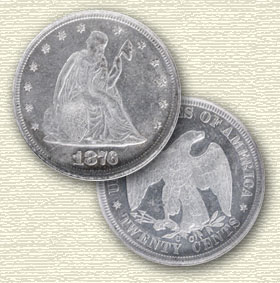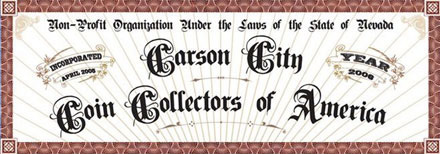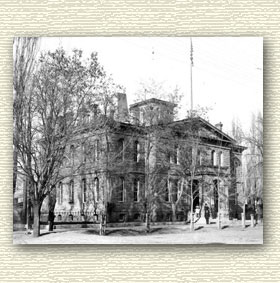- Posts: 499
- Thank you received: 0
Warning: Undefined variable $end_tag_params in /home/c4oa/public_html/libraries/kunena/External/Nbbc/src/BBCode.php on line 2321
Warning: Undefined variable $end_tag_params in /home/c4oa/public_html/libraries/kunena/External/Nbbc/src/BBCode.php on line 2321
1893-CC Eagle CC Coin of the Week Sept. 25, 2011
Warning: Undefined variable $end_tag_params in /home/c4oa/public_html/libraries/kunena/External/Nbbc/src/BBCode.php on line 2321
1893-CC Eagle CC Coin of the Week Sept. 25, 2011 was created by Belayoff
The year 1893 is a tale of many sad endings and very few, hope-filled beginnings. Unfortunately, things would worsen considerably in the years to come. At the beginning of what would soon be known as The Panic of 1893, citizens were still struggling to recover from economic problems spawned in previous decade. Already weakened, the young State of Nevada would experience some of the worst fallout as the country rolled toward a full-fledged depression.
In lock-step with declining Comstock ore production, the value of silver had been falling for years. The effect of these realities, together with the bad news Carson City citizens were soon to hear, would have a devastating effect on the fragile economy of Nevada. With virtually all their eggs in one basket, Carson City and the many communities of Nevada were doomed, never to fully recover from the double blow they would soon receive.
The first blow landed late spring of 1893 when Carson City Mint Superintendant, Theodore R. Hofer received the order to halt mint operations as of June 1, that same year. For 23 years, the mint at Carson City had been a huge part of the economy and brought tremendous pride to the region. Once can easily imagine that people were loath to accept the reality of the mint's final closure.
Given the many politically driven starts and stops the mint had experienced in the previous decade, it's not unreasonable to presume Superintendent Hofer and his employees retained some hope for yet another reprieve. Such hope would have been short lived.
Silver's Money Spigot Closes For Good.
The people of Carson City were well aware of the direction the country was going with regard to the question of a bi-metal monetary system. After all, the elected politicians of the western mining states, including Nevada Senator John P. Jones, of twenty cent piece fame, together with Senators John Sherman, Henry M. Teller, William Stewart with Congressmen Richard P. Bland and the irrepressible William Jennings Bryan had fought tirelessly for years to uphold silver's place as a precious metal in this country.
Despite their passionate speeches, mind boggling filibusters and years of debate and political infighting between the country's silver and gold factions, the door was slammed shut on the nation's silver interests when on October 30, 1893, President Grover Cleveland signed into law, the bill repealing the Sherman Act.
With the formal cessation of the government's silver purchasing obligations, the once burgeoning mines of the Comstock were forced to close for good. After more than three decades of wealth and promise, the Big Bonanza was now the big bust. The fallout was immediate, widespread and devastating. In addition to massive mine closures, dozens of small to medium sized businesses in and around Carson City and the Comstock region closed their doors, including the Territorial Enterprise, of Samuel Clemens' fame and the Wells Fargo Bank in Virginia City and many of their branches around the state.
Rusty Goe writes in The Mint on Carson Street , and I quote, " If you've ever driven through an intersection and been broadsided by a vehicle running a red light, you will have a sense of what the panic of 1893 was like for much of the nation."
One can only imagine the depressing economic climate and social mood in and around Carson City during this period. At the Carson City mint, business volume in 1893 continued to decline precipitously from the high point in 1890. From total production of 2,471,550 coins in 1890, production had dropped to 1,934,732 coins in 1891, 1,502,233 in 1892 and in 1893, just 769,402 coins were minted.
A Meager Half Year's Production
Of the 769,402 coins minted in 1893 at the Carson City facility, 87%, or 677,000 were Liberty Head (Morgan) Silver Dollars, the last vestige of the Sherman Act's largess. The balance of the mint's production that year included 60,000 $5 Half Eagles, 18,402 $20 Double Eagles and just 14,000 1983-CC $10 Eagles, the September 25, 2011 Carson City Coin of the Week.
This article discusses the 101st of the 111* gold and silver coins minted at the United States branch mint facility on the eastern slope of the high Sierra. After a hundred articles, regular Coin of the Week readers will recognize many statistical similarities between the nine different denominations minted between 1870 and 1893 at Carson City. One commonly occurring parallel, especially among the gold coins, is the very small number of remaining examples in mint state condition for each year's various denominations.
With the "sixth largest population" of certified, mint state examples extant, the 1893-CC Eagle might seem to be an exception. In fact, a person unfamiliar with the gold coins of Carson City might assume there would be a generous number of shiny, uncirculated 1893-CC Eagles to chose from. They would be disappointed when the "sixth largest population" of certified, mint state eagles in the entire Carson City series turned out to be a mere nine pieces, of which none are graded higher than MS-62. Such is the rarity of uncirculated Carson City Eagles, to say nothing of extremely rare "choice" and ultra rare "gem" quality, uncirculated Carson City Eagles in the nineteen-year series.
Expensive versus REALLY Expensive!
With the exception of a handful of years, any certified Carson City Eagle in mint state condition is expensive and generally out of reach for the average coin collector. Even with the sixth largest population of uncirculated examples, a certified 1893-CC Eagle in just MS-60 or MS-61 will set a person back no less than $11,000 to $12,000. Sale records of several MS-61 pieces sold over the three years substantiate this cost range, including an NGC graded MS-61 example which sold for $12,650 just last month.
With only four pieces known to exist in MS-62, and none higher, one would expect the price for such a coin to jump exponentially. Accordingly, it was no surprise to this writer that the lone sale record found for an MS-62 graded 1893-CC Eagle was an NGC certified coin, which sold for a whopping $32,200...and that was back in 2006!
Lowest Extant Population of CC Eagles in the 1890's.
Even though the Carson City mint conducted business for only five months during 1893, the big coin presses still pumped out 14,000 $10 gold eagles. While this total was considerably less than each of the preceding three years, the 14,000 production total is actually the sixth highest mintage total for the entire series.
Be that as it may, most published sources agree that only 300 to 325, 1893-CC Eagles remain today, all grades include. This number is by far the lowest population of the four production years during the 1890's. Even though this total represents only 2.3% of the original 14,000 coins produced, 1893-CC Eagles are more abundant, all grades included, than 14 of the 19 dates in the Carson City eagle series.
Collectible in XF and AU Grades.
In this writer's opinion, the 1893-CC Eagle, in circulated condition, is an excellent candidate for a ten piece Carson City type set. The date is affordable in AU and XF condition, yet it's definitely not the most common date in the series. An interested collector will have about 100 pieces to choose from combined in NGC and PCGS XF holders and well over 200 certified AU coins, NGC and PCGS inclusive.
Additionally, 1893 Eagles are generally well struck and many have a reasonable amount of remaining luster. Another benefit of the 1893-CC Eagle is that very few are found with unsightly copper spots.
There are no known varieties for the 1893-CC Eagle. The mint produced the coin using the same reverse die used in 1892. The large, slanting date, placed low in its designated space on the coin's obverse, is a diagnostic of genuine 1893-CC Eagles.
Auction records indicate XF graded pieces can be purchased between $1,100 and $1,500. Almost uncirculated coins start around $1,650 in AU-50 and range up to $3,000 for a nice AU-58 coin.
Proof of Proof ?
Rusty Goe makes an interesting point about the 1893-CC Eagle in his important, 2003 publication, The Mint on Carson Street. Given the probability that the employees of the mint knew it was the last year of production, it seems strange that no specially prepared "specimen" examples seem to have been produced. At the time of his publication in 2003, Rusty was comfortable stating there are "no exceptional specimens of this date known to exist".
Today, eight years later, NGC has certified three proof-like, 1893-CC Eagles, one in MS-61 and two in AU-58. Other proof-like coins from1893 have been identified in other denominations as well. While these proof-like examples are no guarantee that some coins may have been specially prepared in commemoration of the mint's final production year, they do give one pause to wonder.
A person would think that any certified, proof-like coin minted, potentially in commemoration of the Carson City mint's last year of operation, would command a serious premium. However, an 1893-CC Eagle in an MS-61 NGC proof-like holder recently sold at a Heritage auction for just $12,650, well within the range of other non-proof-like pieces.
The Rian's Bequest Carson City coin collection is fortunate to own the lovely 1893-CC Eagle pictured at the top of this article. The coin is very bright and lustrous and is a delight to examine. The following is the original description given the coin by Rusty Goe;
The coin displays all the characteristics of an AU-58 specimen, but PCGS knocked it down a grade because of the friction visible in the obverse fields. None of the hairlines or marks is severe, but they are noticeable. The details, as usual on this date, are sharply struck—the eagle’s breast and wing feathers are exceptionally bold. Overall, this piece deserves every point, and then some, of the AU-55 grade level.
Given the heavy heart the Carson City mint's employees must have carried through their last year employment, it's safe to say that this collector has received a lot more enjoyment from owning this single coin, than the mint's employees gained from manufacturing the whole batch of 1893-CC Eagles, the Carson City Coin of the Week for September 25, 2011.
Belay Off
* Total number of coins including all denominations for all years produced at Carson City from 1870 to 1893, not including varieties.
C4OA Lifer!
Please Log in to join the conversation.
Warning: Undefined variable $end_tag_params in /home/c4oa/public_html/libraries/kunena/External/Nbbc/src/BBCode.php on line 2321
Replied by Carsonite on topic Re:1893-CC Eagle CC Coin of the Week Sept. 25, 2011
So many nation-changing (and world-changing) things happened in 1893. Starting that year, U. S. citizens faced similar uncertainties shared by those of us alive today. As usual, politics and economics fueled the fears. The shutting down of coining operations at the Carson City Mint in 1893, while not having much effect on the rest of the nation, certainly cast a gloomy cloud over life in Nevada's capital.
Still, the coins survive and give us collectors much to ponder. You have covered the key points in your COTW article. In so doing, you have paved many pathways that lead to many interesting topics of discussion.
By introducing the battle over monetary standards and mentioning William Jennings Bryan, you opened a wide door to a subject whose consequences reverberate to the present day.
President Cleveland, a staunch believer in the gold standard, refused to inflate the money supply with silver, thus alienating the agrarian populist wing of the Democratic Party. He favored the banking industry, which was considered one of the ruling classes of its day. Bankers opposed inflating the money supply because it favored their debtors. William Jennings Bryan, only 33 years old at the time, took up the debtors' cause, which won him support from silverites and agrarians (farmers), who stood to benefit the most from an increased money supply.
By 1896, Bryan won the Democratic Party nomination for the presidency (He would also win the nomination in 1900 and 1908). During his rise to power the price of silver dropped below 50 cents an ounce. He called for a return to bimetallism, which would effectively bring silver's price to parity with gold's price. Paper money would be issued to represent the inflated-priced silver. Political opponents mocked Bryan, using campaign tactics such as printing fake dollar bills, which had Bryan's face and which read "IN GOD WE TRUST...FOR THE OTHER 53 CENTS," thus illustrating their claim that a dollar bill would be worth only 47 cents if it was backed by silver instead of gold.
Ironically, the monetary reforms suggested by Bryan back in the 1890s resemble the Quantatative Easing and stimulus plans used by a Democratic-driven government today. Circumstances were different in the 1890s, however, and millions of working-class citizens viewed Bryan as a hero rather than a goatlike figure like Obama or Bernanke. Bryan's Cross of Gold speech, delivered at the 1896 Democratic National Convention in Chicago on July 8, 1896, is considered one of the most powerful campaign speeches in history.
You wrote,
This is a fact all "CC" coin enthusiasts should always remember.A Meager Half Year's Production
At the Carson City mint, business volume in 1893 continued to decline precipitously from the high point in 1890. From total production of 2,471,550 coins in 1890, production had dropped to 1,934,732 coins in 1891, 1,502,233 in 1892 and in 1893, just 769,402 coins were minted.
You also gave us something to think about when you wrote,
Your whole COTW article gives us so many pauses to wonder. Way to go.NGC has certified three proof-like, 1893-CC Eagles, one in MS-61 and two in AU-58. Other proof-like coins from1893 have been identified in other denominations as well. While these proof-like examples are no guarantee that some coins may have been specially prepared in commemoration of the mint's final production year, they do give one pause to wonder.
Rusty
P.S. I will bet that your article will induce some readers to seek out an 1893-CC $10 gold piece.
C4OA Lifer!
Please Log in to join the conversation.
- coindrummer
-

- Offline
- Platinum Member
-

- Michael D. Parrott
- Posts: 775
- Thank you received: 0
Warning: Undefined variable $end_tag_params in /home/c4oa/public_html/libraries/kunena/External/Nbbc/src/BBCode.php on line 2321
Replied by coindrummer on topic Re:1893-CC Eagle CC Coin of the Week Sept. 25, 2011
My hat's off to you for yet another exemplary COW post of a most important (and sad) "final year of production" coin.
I had no idea that you were in "stewardship" of a PL 1893-CC eagle! An amazing coin to say the least.
You truly covered all the bases in your review and made me realize again that there's far more to coin collecting and numismatics than simply the acquisition of rarities, there's boat-loads of historic info behind every single "CC" coin. You have obviously done your research here!
the drummer
C4OA Lifer!
Please Log in to join the conversation.
Warning: Undefined variable $end_tag_params in /home/c4oa/public_html/libraries/kunena/External/Nbbc/src/BBCode.php on line 2321
Replied by Belayoff on topic Re:1893-CC Eagle CC Coin of the Week Sept. 25, 2011
Thanks for the in depth, scholarly expansion of my very generic article about the 1893-CC Eagle. Certainly, Bryan and the political intrigue during his time is a massive story in itself.
I particularly enjoyed the chapter on 1893 in "The Mint on Carson Street" which provides a good feel for so many of the important "players" on both sides of the precious metals conflict.
I remember one of my college professors reading a portion of Bryan's famous Cross of Gold speech to the class in one of my business courses. Your comments inspire me to look it up and read it once more.
Belay Off
C4OA Lifer!
Please Log in to join the conversation.
Warning: Undefined variable $end_tag_params in /home/c4oa/public_html/libraries/kunena/External/Nbbc/src/BBCode.php on line 2321
Replied by Belayoff on topic Re:1893-CC Eagle CC Coin of the Week Sept. 25, 2011
I do not own that stellar MS-62 PL piece and apologize if my article seemed to imply that I did. My AU-55 example of the 1893-CC Eagle coin is much nicer than the photo presents. I would be loath to trade it, even for an MS coin of the same year.
Hope all is well at the beach.
Belay Off
C4OA Lifer!
Please Log in to join the conversation.
- coindrummer
-

- Offline
- Platinum Member
-

- Michael D. Parrott
- Posts: 775
- Thank you received: 0
Warning: Undefined variable $end_tag_params in /home/c4oa/public_html/libraries/kunena/External/Nbbc/src/BBCode.php on line 2321
Replied by coindrummer on topic Re:1893-CC Eagle CC Coin of the Week Sept. 25, 2011
There' the picture of your 1893-CC AU-55 eagle. A most splendid example of a much rarer date than some give it credit for.
I don't have one yet but Carsonite is correct when he said that your article would make folks want to get one...I'm one of those folks! I just gotta get me one...:woohoo:
the drummer
C4OA Lifer!
Please Log in to join the conversation.


